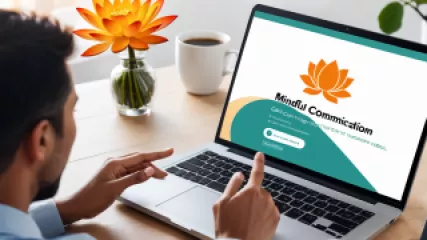How to Improve Mindful Communication for Effective Virtual Therapy Sessions
Improving Mindful Communication for Effective Virtual Therapy Sessions
In today's increasingly digital world, virtual therapy sessions have become a common and convenient way for individuals to access mental health support. However, effective communication is essential for these sessions to be truly impactful. That's where mindful communication comes into play. By cultivating mindful communication skills, both therapists and clients can enhance the quality of their virtual therapy interactions and achieve more meaningful outcomes.
What is Mindful Communication?
Mindful communication is the practice of being fully present and attentive during a conversation, while also being aware of one's own thoughts, emotions, and physical sensations. It involves actively listening, speaking with intentionality, and maintaining a compassionate and non-judgmental approach.
In the context of virtual therapy sessions, mindful communication is particularly crucial. When we interact through a screen, it can be easy to become distracted or disengaged. Mindful communication helps to bridge this gap, ensuring that both the therapist and the client are fully present and able to connect on a deeper level.
The Benefits of Mindful Communication in Virtual Therapy
Practicing mindful communication in virtual therapy sessions can lead to numerous benefits, including:
- Improved Rapport and Trust: When both the therapist and client are fully present and attentive, it fosters a sense of trust and safety, which is essential for the therapeutic process to be effective.
- Enhanced Understanding: Mindful communication allows for better comprehension of the client's thoughts, feelings, and needs, enabling the therapist to provide more tailored and effective support.
- Increased Emotional Connection: Even in a virtual setting, mindful communication can help create a stronger emotional connection between the therapist and client, making the therapy experience more meaningful and impactful.
- Better Retention and Outcomes: Clients who engage in mindful communication during virtual therapy sessions are more likely to retain the information and strategies discussed, leading to better overall outcomes.
Strategies for Improving Mindful Communication in Virtual Therapy
Developing mindful communication skills is an ongoing process, but there are several strategies that both therapists and clients can implement to enhance their virtual therapy experiences:
1. Create a Conducive Environment
Ensuring that the virtual therapy space is free from distractions and interruptions is crucial for cultivating mindful communication. This may involve:
- Choosing a quiet, private location for the session
- Turning off notifications and silencing devices
- Minimizing background noise and visual clutter
- Ensuring a stable and reliable internet connection
By creating a distraction-free environment, both the therapist and client can better focus on the present moment and engage in mindful communication.
2. Practice Active Listening
Active listening is a fundamental aspect of mindful communication. This involves:
- Giving the speaker your undivided attention
- Avoiding the temptation to formulate a response while the other person is speaking
- Asking clarifying questions to ensure understanding
- Paraphrasing or summarizing the speaker's key points
- Demonstrating empathy and validating the speaker's emotions
When both the therapist and client practice active listening, it fosters a sense of being truly heard and understood, which is crucial for building trust and rapport.
3. Speak with Intention
In addition to listening mindfully, it's important to speak with intention and clarity. This includes:
- Choosing words carefully to convey your message effectively
- Speaking at a pace that allows the listener to process the information
- Checking in with the listener to ensure they understand what you're saying
- Being aware of your tone, body language, and facial expressions
By speaking with intention, the therapist can help the client feel more engaged and supported, while the client can communicate their needs and concerns more effectively.
4. Practice Mindfulness Techniques
Incorporating mindfulness techniques into the virtual therapy session can help both the therapist and client stay present and focused. This may include:
- Engaging in a brief mindfulness meditation before the session
- Taking periodic mindful pauses throughout the session to check in with one's own thoughts and emotions
- Encouraging the client to practice mindful breathing or body awareness exercises during the session
By integrating mindfulness practices, the therapist and client can cultivate a greater sense of self-awareness and presence, which can enhance the overall quality of the virtual therapy experience.
5. Provide Regular Feedback and Reflection
Regularly checking in with each other and reflecting on the communication dynamics can help improve mindful communication over time. This may involve:
- Asking for feedback on the effectiveness of the virtual therapy session
- Discussing any challenges or areas for improvement in the communication process
- Collaborating on strategies to enhance mindful communication in future sessions
By engaging in this ongoing process of feedback and reflection, the therapist and client can continuously refine their mindful communication skills and ensure that the virtual therapy experience remains meaningful and impactful.
Overcoming Challenges in Mindful Communication for Virtual Therapy
While the benefits of mindful communication in virtual therapy are clear, there can be some unique challenges to navigate. Some common obstacles include:
- Technical Difficulties: Issues with internet connectivity, audio/video quality, or screen sharing can disrupt the flow of communication and make it more challenging to maintain mindfulness.
- Distractions and Multitasking: It can be tempting for both the therapist and client to become distracted by email, social media, or other tasks during the virtual session, undermining the mindful communication process.
- Lack of Non-Verbal Cues: Without the ability to fully observe body language and facial expressions, it can be more difficult to pick up on subtle emotional cues and maintain a deep level of connection.
- Comfort with Technology: Some individuals may feel less comfortable with virtual communication, which can create barriers to engaging in mindful dialogue.
To overcome these challenges, it's essential for both the therapist and client to be proactive and adaptable. This may involve:
- Troubleshooting technical issues in advance and having a backup plan for connectivity issues
- Establishing clear boundaries and expectations around distractions and multitasking
- Actively seeking and responding to verbal and audio cues to compensate for the lack of non-verbal communication
- Providing support and guidance to the client in developing their comfort and confidence with virtual communication
By addressing these challenges head-on and collaborating to find solutions, the therapist and client can maintain a high level of mindful communication even in a virtual setting.
The Role of Positive Affirmations in Mindful Virtual Therapy
Positive affirmations can be a powerful tool for enhancing mindful communication and overall well-being within virtual therapy sessions. Affirmations are positive statements that challenge negative or limiting beliefs and encourage the client to focus on their strengths, capabilities, and desired outcomes.
In the context of virtual therapy, positive affirmations can help the client:
- Overcome feelings of isolation or disconnection that can arise in a virtual setting
- Cultivate a more positive and empowered mindset, which can contribute to better mental health outcomes
- Reinforce the therapist-client connection and the client's sense of being heard and understood
- Boost self-confidence and resilience, enabling the client to engage more actively in the therapeutic process
Therapists can incorporate positive affirmations into virtual therapy sessions in various ways, such as:
- Introducing affirmations at the beginning of the session to set a positive tone
- Encouraging the client to repeat affirmations during mindfulness exercises or throughout the session
- Providing the client with a list of personalized affirmations to practice between sessions
- Modeling the use of affirmations and inviting the client to share their own positive self-statements
By integrating positive affirmations into the virtual therapy experience, both the therapist and client can cultivate a more mindful, supportive, and empowering environment for personal growth and healing.
The Future of Mindful Communication in Virtual Therapy
As virtual therapy continues to grow in popularity and accessibility, the importance of mindful communication will only become more pronounced. As technology evolves and virtual therapy platforms become more sophisticated, there will likely be increased opportunities for therapists and clients to engage in even more immersive and interactive mindful communication practices.
Some potential developments in this area may include:
- Virtual Reality (VR) and Augmented Reality (AR) Therapy: The integration of VR and AR technologies into virtual therapy sessions could enable more realistic and immersive communication experiences, allowing for a greater sense of presence and emotional connection.
- Biofeedback and Physiological Monitoring: The incorporation of biofeedback and physiological monitoring tools into virtual therapy could provide valuable insights into the client's emotional and physical state, enhancing the therapist's ability to tailor their communication and interventions accordingly.
- Artificial Intelligence (AI) Assistants: AI-powered virtual assistants could potentially be leveraged to provide real-time feedback and guidance on mindful communication techniques, helping both the therapist and client to optimize their interactions.
- Collaborative Virtual Spaces: The development of more interactive and collaborative virtual therapy environments could foster a greater sense of shared experience and connection, further enhancing the mindful communication process.
As these and other technological advancements continue to emerge, it will be essential for therapists and clients to remain adaptable, curious, and committed to the principles of mindful communication. By embracing these evolving tools and techniques, the virtual therapy experience can become increasingly enriching, meaningful, and impactful for all involved.
Conclusion
Mindful communication is a crucial component of effective virtual therapy sessions. By cultivating the skills and strategies outlined in this article, both therapists and clients can enhance the quality of their virtual interactions, deepen their therapeutic connection, and achieve more meaningful and lasting outcomes.
Whether you are a seasoned therapist or a client seeking support, the consistent practice of mindful communication can transform the virtual therapy experience, empowering you to navigate the digital landscape with greater presence, empathy, and resilience. Embrace the power of mindful communication and unlock the full potential of virtual therapy for your personal growth and well-being.






